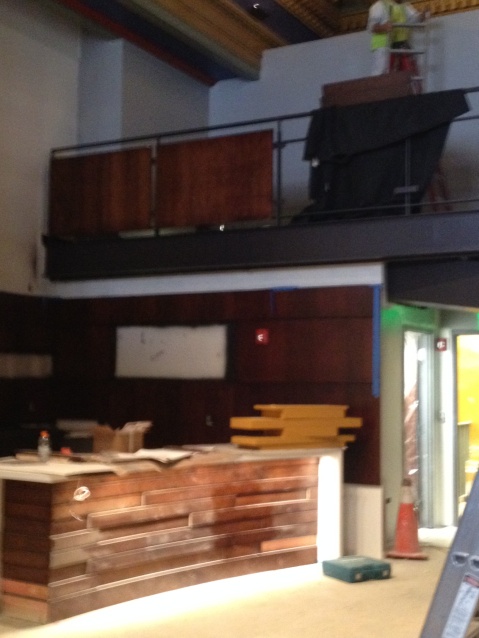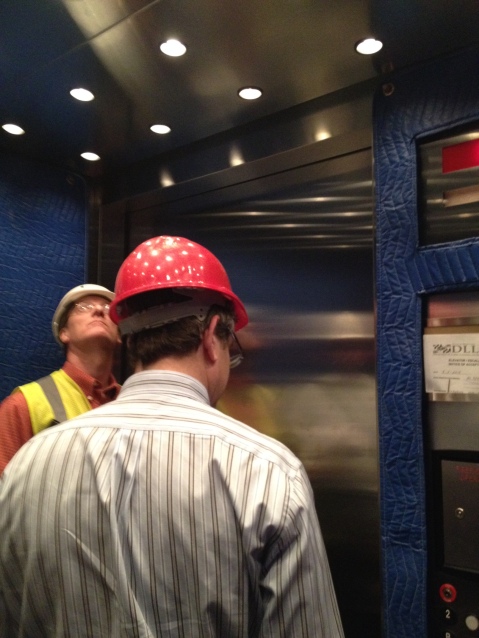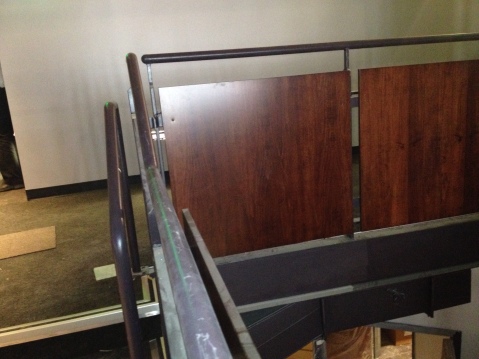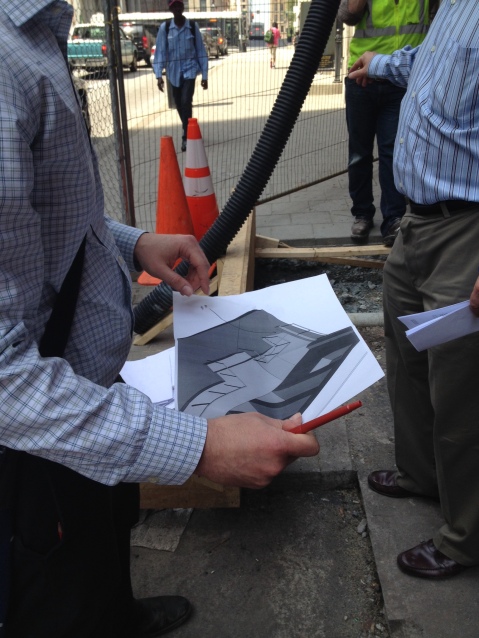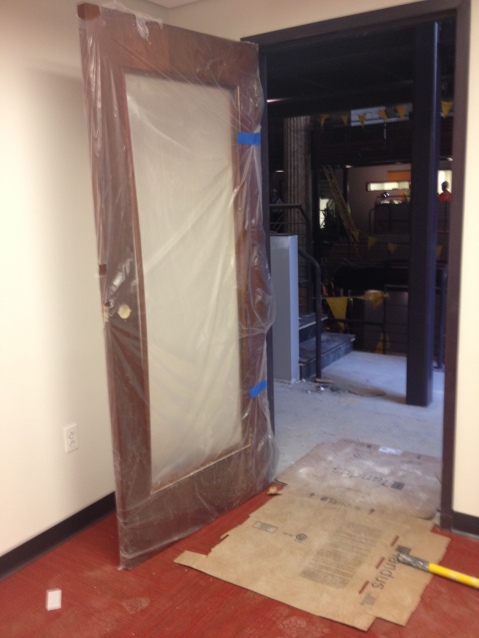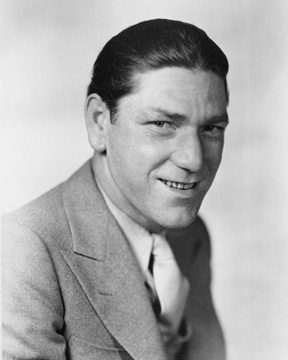Near The End of the Usefulness of This Blog
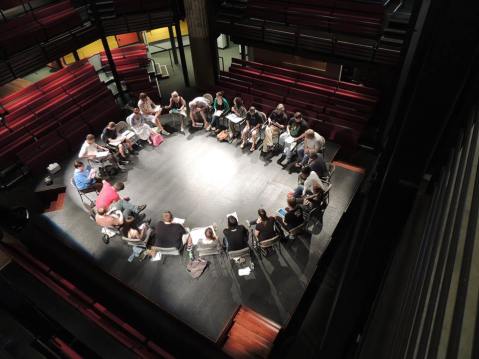 Well, it’s sort of built. On second thought, it is but it isn’t. It’s a beautiful thing. It really is. I can’t wait for people to see it for what it was built for: to see live theater. I think it’s really going to knock people out.
Well, it’s sort of built. On second thought, it is but it isn’t. It’s a beautiful thing. It really is. I can’t wait for people to see it for what it was built for: to see live theater. I think it’s really going to knock people out.
There are a few things that need to be done before opening and there will be a few things that’ll need to be done after opening and in the years to come, but it’s basically there. We’ve been rehearsing in it for a week now and it shows off its strengths and weaknesses. It’s such a beautiful stage to work with, that one can get lazy on it. It does so much of the work, it’s easy to say “well, that looks good” and leave it alone. It is a theater that will invite directors, actors and designers to get lazy.
It’s a joyous place for artists to work. You can see that every rehearsal. We’re all so happy to be there and working.
There are so many details to the building of this. There are so many people that were involved in its creation. Some of the memories I have about the process were: the great pride Steve Schwenk from Cho Benn Holback had in every detail and the great humor that he and Khanh Uong and George Holback brought to everything, the ability of George to interpret what we had to say into a design and the ability of Khanh’s to come up with alternatives on a dime.
I think of the great care and sincere support for the project from Southway Builder’s John Diehl and the enthusiastic and diligent (and omnipresent) Sean Scott who everyone liked right away and continued to like through the whole process. We grew to really like he Southway team of John, Ken, Sean and Dominick .
I think of Lesley Malin’s great diligence and insistence on getting the Steeldeck seating installed and Scott Helm’s great diligence and insistence that EVERYTHING got done right. I think of Dan O’Brien’s calm and thoughtful advice on so many details (including the entire lighting and sound systems!) and I remember helpful advice from people before we even started building- smart folks like Michael Hood from IUP, Jeff Watkins from Atlanta Shakespeare, Ralph Alan Cohen from American Shakespeare Center, Vince Lancisi from Everyman Theatre, Christopher Gaze from Bard on the Beach, Steve Beall from, well, from CSC and many others.
Sure, there were some people who gave advice that this couldn’t or shouldn’t be built or that what we were doing was “wrong,” but, I think we’ve forgotten all of that. Because now it has
And you know something else? The neighborhood has already started to change a bit. We can see it (and not just in all the new development that is happening all around us). It is so exciting to be part of this reimagining of Downtown Baltimore. It truly is.
Post Morphine Questions
As the Morphine runs out from my past surgery, a whole bunch of questions have emerged. Some of them come from me, others come from others. Here is a brief sampling of questions that need to be answered in a very short amount of time:
How does the laptop interface with the sound board? Can we use WiFi technology to operate the sound remotely? What are the most efficient box office hours? How and when am I going to pick out the couch for my office? How many ellipsoidal instruments do we need? (I mean, need not want). What hours of the day do we have music piped out to the external speakers in the street? Do the speakers go to Redwood or Calvert or both? Can Lesley get the kind of dry erase paint she’s been thinking about for her office? What will be my work schedule? How can we make sure that all of our board members and their families feel they they are an important part of opening weekend? What does “zero” look like on the LED controlled house lights? How many people can comfortably fit into the PNC Family room? How will we notify our audience that that room is full? Can non-full time employees make a weekly Wednesday 6:00 production meeting? How much illumination will be given off by the red exit signs?
How many people can comfortably fit in the “common areas” on the main floor? How about the mezzanines? How many people (audience members) can “mingle” on the stage? The green room won’t be green. Will that matter at all? Or are all the stories about green rooms being green just stuff of show biz mythology? How can A Christmas Carol costumes be built while Richard II is being built? Acoustics, acoustics, acoustics!!! What about them? How will we get a piano for the piano bar? Since much of the audience will view the shows at multiple vertical levels, how will that change the subconscious visual experience? I know of all sorts of properties in staging that can affect audiences in subliminal ways, but this stage expands way beyond the traditional. It’s like the difference between regular checkers and 3-D checkers. I think. Or is it?
How much sound does a glass being poured at the bar make? What about ice? If we are going to serve drinks during the show, do we need to bar ice? Do the shows start on time? Are they designed to start five minutes late? What do we do when an audience member complains about arm rests? Where do we store the cycloramas when we’re not using them? Considering we will have key production staff working their tails off getting the first show up and ready, how will we have enough support to manage and run the opening gala festivities? When are we going to take the gum off the sidewalks? How long does it take an actor get from backstage to the aisles on the main level? How long to get to the mezzanine not using the spiral staircase? How much time when using the spiral staircase?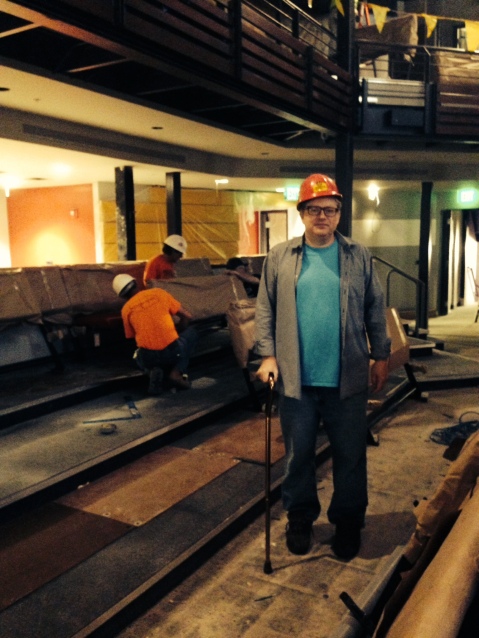
How well will gobos show up on our black stage surface? How long will it take to change between Uncle Vanya and Importance of Being Earnest sets? If we light the ceiling, will we inadvertently be lighting the booth as well? If the company we’ve hired to manage and build our system for selling tickets are unable to have the system function properly;, and they’re not sure why, what then? How much of our marketing effort ought to be aimed towards subscriptions vs single tickets? How much toilet flushing will be able to be heard from the audience? What do the trash cans look like?
We’re selling a substantial amount of five show subscriptions- that’s good. But, since, as individual ticket sales, they are priced well below or budgeted $/ticket, there will be a time when we need to revise our attendance goals, because they’ve now changed. When is the appropriate time? Where will the school buses go after they’ve dropped off the kids? Who’s got that $700K that we need? When do we start on our post-opening strategic plan?(cause we need one). Some of our company members are very good at including the audience in ways beyond direct address, some are not. How do we get the ones who are not up to speed in this very complex theater?
Did we ever solve the issue with the House Manager’s responsibilities? I don’t think we did. Are we insured against vandalism on the new poster boxes? Is it time to start keeping archives of prompt books? Survey’s continually show that panhandling contributes greatly the fear that people have related to spending time in downtown areas. What can we do to cut down on the amount of pan handling that happens right around our building? When will I have time to write the employee handbook? How can we make those cool rotating wagons from the movie about Theatre du Soliel work? Where will my Dad sit where he’ll be comfortable and will be able to see and hear? What will be the running time of A Christmas carol? Richard II? What percentage of our early subscribers are Baltimore centered vs HoCo centered? How many are previous customers vs brand new? Is there a way we can figure out how to do popcorn?
Wow. It’s so cool!
 Gee whiz! building a theater keeps you busy. I knew it would. I was all ready for it and everything, but still, when you’re in the thick of it. It’s a lot. We’re about two months from completion of construction- maybe a month after that for hanging lights and speakers. We’re on schedule.
Gee whiz! building a theater keeps you busy. I knew it would. I was all ready for it and everything, but still, when you’re in the thick of it. It’s a lot. We’re about two months from completion of construction- maybe a month after that for hanging lights and speakers. We’re on schedule.
We’ve got a lot of fund-raising still to do. Right now, that’s the most taxing part. We’ve done extraordinarily well in this regard- we’ve raised over five million dollars so far (about $5.25M to date). We’ve done that in less than 18 months- so that’s incredible, but, we have to be more than incredible, we have to be perfect. We’ve got about $700K to raise to complete the cost of the building and then another $800K to raise for the “operating reserve.” – That’s the piece that allows us to grow in a healthy manner rather than have to succeed from day one of opening. It may not seem like much in terms of percentages- but, trust me, it’s a lot of money to raise.
We have about five months to do that. Maybe, just maybe we have a bit more time with the operating reserve but yet- that’s hard and, like I said, no room for error.
So, that puts us in a place right now where it’s hard to be proud of our accomplishments, because we’re so focused on what is still to do. You know, when you’re running a marathon I presume you don’t think, at mile 21, “gee I’m proud of what I’ve accomplished so far.” No, my guess is that you’re focused on the finish line and how much its going to take to get there.
There’s also a weird tension about success. Everyone (and I mean everyone) wants to know that a fund raising campaign like this is going well, that it’s being successful. I mean, who wants to donate money to something that’s not going very well? But the tension is to make sure people know that, while its successful, it won’t ultimately be that without their help. That’s the case here. People are rooting us on- cheering our success, but we have to make the case that their support is the only way we make it to the end.
That’s where we are.
The building itself will be done and ready to open in September. It’s really a remarkable thing to see. Next week, we’re starting to build the stage. A week or so after that, the seats will come in. The sense that I get is that its even more amazing than anyone thought it would be. Our expectations are high, but we’re exceeding them. It’s amazing to be in the building when work is being done. There are literally dozens of people all working at the same time. You know how sometimes you drive by road construction and you see two guys working and ten guys standing around? Well, this is the opposite. Lots of hard work by a lot of people (many of whom we don’t even know) is going into this project. If anyone had any doubts about what could be achieved in Baltimore, they just need to stop by and see what’s going on- lots of hard work from a wide variety of skilled and caring people.
So, still we’re trying to run the everyday operations of the Chesapeake Shakespeare Company while doing a large amount of planning for our first season in the new building. If I can share with you a phenomenon … You know, we’re quite aware that, in order to “earn” this building, our work has to be innovative, exciting, note-worthy, etc… You don’t get to have a building like this and get lazy- do your same old same old work. You can’t say to yourselves “well, we’ve arrived so I don’t have to learn anything new now.” My perspective of this expansion is that we all have to work harder, better and get smarter. That’s not really anything new- that’s our responsibility as artists- to always be thriving to get better, to learn new things.
So, you get a lot of buy-in for that idea in the abstract. If you suggest that in a room full of people, you get a lot of nodding heads. Many people get this and take it to heart. But, sometimes you run into this situation: people will hear that, agree with it but somehow think you’re talking about someone else. “Oh, I thought you meant THEY all had to work harder and get better and learn more stuff. I didn’t think you meant me.”
So, that’s an area that sometimes makes me sigh loudly. Am I guilty of this as well? Oh, I’m sure I am from time-to-time. It’s just an amazing thing to watch. We’ll have to come up with a solution to that.
Mmm. now that I think of it- maybe there’s the same phenomenon with fund-raising. Right? You don’t want people in a room to agree with you that you have to raise more money, you want those people to pitch in.
O Canada
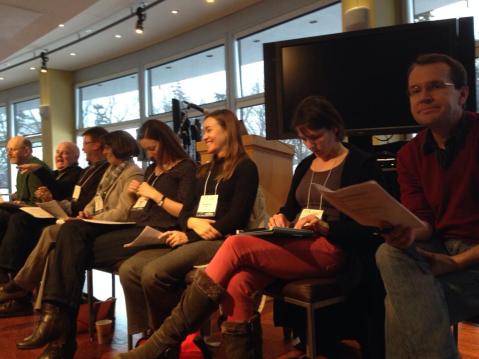 We’re not allowed to go into the building for a week or so because they’re pouring concrete. That’s some serious progress. I think that, after that, the shell of the theater will be in place. Of course, there are stairs to install, seats to install, walls to be erected, but the basics will be there very soon. Also, we’ve made a deal with a local parking garage for $5 parking for our patrons. That’s awesome!
We’re not allowed to go into the building for a week or so because they’re pouring concrete. That’s some serious progress. I think that, after that, the shell of the theater will be in place. Of course, there are stairs to install, seats to install, walls to be erected, but the basics will be there very soon. Also, we’ve made a deal with a local parking garage for $5 parking for our patrons. That’s awesome!
That’s not what I want to talk about.
I’m at the annual Shakespeare Theatre Association conference. This year, we’re at the Stratford Festival in Ontario, Canada. This place is one of the key centers of Shakespeare production around the world. I came here armed with having read two great books about the festival- one about its founding, the other a biography of one of its Artistic Directors. I made trip here a couple of years ago and saw a bunch of plays- some I liked a lot.
I love this conference. Each and every year, I come back energized. This year will be no exception. It’s an incredible thing to spend three days with so many creative, smart people. Okay. I’m going to mention some names here because I am so grateful to each of these people for what I learn from being in their presence. My relationship with each of them may be very different and the ways I interact with them are different as well, but I owe each of them from what they have given me this year.
I had so much fun the other night having dinner with my friends Ralph Cohen and Christopher Gaze, founders of the American Shakespeare Center and Bard on the Beach in Vancouver BC. Both are real heroes of mine- brilliant men in their own ways who are changing the nature of how we receive Shakespeare in North America. My friend Ralph is a southerner, raised in Alabama and now in Virginia and Christopher is a Brit ex-pat who has lived in Canada for the last 40 years. Joining the three of us were Lesley, Jenny and Giles Block, Master of text at Shakespeare’s Globe in London. Jesus, the brain power that was at that table! I just listened and learned.
Founder of the L.A. Women’s Shakespeare Project Lisa Wolpe is also one of my heroes. She is a brilliant artist whose work and story I adore. She has inspired a middle-aged white guy like me to include gender and race in my work as an artist. Why? Because to be an artist in our world in 2014 and to ignore race and gender is to be an artist who is blind to the world.
I am so fond of Jeff Watkins, the founder of the Atlanta Shakespeare Company and Stephen Burdman, the founder of New York Classical. I am fortunate enough to call both of these guys friends, but also brothers in arms. These guys are taking Shakespeare away from people who want to keep it for their very own. They’re opening up the doors to the bastille and are fervently sharing Shakespeare with everyone!
Fred Adams is the octogenarian founder of the Utah Shakespeare Festival. Fred is always at STA. His kindness and generosity is always on display. In addition, he is very selective about when he chimes into the larger conversations, but when he does, he’s a freakin’ genius. Here is a man that helped create the phenomenon of Shakespeare in America. I very very fortunate to spend time with him.
Okay, so I started and I don’t know when to stop. Shakespeare Behind Bars’ Curt Tofteland is always an inspiration to me. Whenever Toby Leavitt or Rebecca Ennals talk, I listen because they are so very smart. I’m always so happy to see Clark and Melissa Nicholson from Harrisburg Shakespeare, Grant Mudge from Notre Dame Shakespeare, Scott Phillips from Utah and so many more that I need to stop listing them. Oh yeah and Patrick Spottiswoode – from Shakespeare’s Globe who has, over the years, been such a good friend to me and to the Chesapeake Shakespeare Company.
There is nothing like having the privilege of enjoying the company of artists who you admire. I feel so grateful to have the opportunity to spend time with these wonderful people.
Also, I’m always so grateful and proud to be in the presence of Lesley, Jenny and Kevin from CSC.
And, of course, now is the time that I take all of their brilliant ideas back to Maryland and implement them and try to remember to give the credit to the people that gave us all these great ideas.
They’re ALL helping us to build this theater
An Update From My Red Chair
 So, some of you might know that I’m in the later stages of recovery from hip replacement surgery. I’m very anxious to get back to work, but I’m not quite ready yet. And, although this blog isn’t intended to be official by any means, I thought I would share with my readers a progress report of where we are with the project. It’ll give me something to do.
So, some of you might know that I’m in the later stages of recovery from hip replacement surgery. I’m very anxious to get back to work, but I’m not quite ready yet. And, although this blog isn’t intended to be official by any means, I thought I would share with my readers a progress report of where we are with the project. It’ll give me something to do.
On the money side of things- things are going well. Our campaign consists of raising $6.7 million (which includes around $900K in operating reserve) and, to date, we’ve raised about $4.5M. Obviously, we have some work to do still (and less than a year to do it in), but we are making very good progress. We are asking the State of Maryland to make an additional investment beyond last year’s funding as well as the City of Baltimore. As you might guess, those processes take some time. They might account for a significant portion of the $2.2M we have left to raise (although, certainly not of all it).
We’ve been able to award some naming rights to various pieces of the building. That’s been fun. We’ve awarded naming rights to the stage, the green room, the library, the upstairs lounge and most likely the downstairs bar. There are still some major things left to name though. I would hope someone will have a desire to name the “family room” that will be in the old bank vault.
We continue to talk to individuals, government officials and private foundations about their support for the project. It’s going well. Scott Helm, Lesley Malin and Jenny Leopold have been a dynamic team doing this work. Each seem to bring different, unique talents to the process- each complimenting each other in important ways. Claire Seigel and Liz Berman have also contributed greatly to the effort and bring their own unique skills to the effort. No one would confuse any one of the five for another one, and I think that may be the key to their success.
The building is coming along just fine as well. Because of where we are in the renovation, it’s a little harder to see. The “destruction” phase of the project is pretty much done. It looks very much like an old bank and very little like an old nightclub these days. They are bringing in pre-fabricated steel these days. That’s the first thing they’ll need to build the additional structure- updating the mezzanine and building the second mezz, etc. They’ve also been working on the elevator, which seems like a minor piece of things, but feels elemental. Also, the clean up and restoration of the exterior continues. It’s a beautiful building. We look forward to it looking that way from streetside.
Lesley is our key “seating person” and has been hard at work creating custom made seating to fit our unique space. The trick about building a unique theater is that you really have to pay attention to everything- not much comes “right out of the box.” The seating is one of the last things to go in. We don’t expect them to actually be installed until probably early May, but because of the custom nature of them, we need to work on them now.
It looks like we have a new address for the building. We wanted to change it from a Redwood Street address to a Calvert Street address (for reasons explained in a previous blog entry). It looks like we’ve decided on 7 South Calvert Street.
I’ve started splitting my focus – half on the building/capital campaign and the other half on programming for the new building. As you know, I’ve been thinking about this kind of expansion for years and years, but now is time to put things in motion. We’ve chosen a season (we’re unable to share it with you yet) and started finding places for our resident artists. We’ve started scheduling educational programing and building relationships with schools and other organizations.
I am confident that we will be opening our doors to our community on the scheduled date in late 2014. I’ll keep you posted.
From an email
The plumbing inspector reviewed our underslab work yesterday, but wants a check valve installed [under the slab] just for the bsmt fixtures. I have our  plumber reviewing the changes and I’ll forward a cost proposal once I receive their info. It’ll involve some add’l bsmt floor slab removal, some underslab plumbing rework, and some above slab proposed plumbing re-routing.
plumber reviewing the changes and I’ll forward a cost proposal once I receive their info. It’ll involve some add’l bsmt floor slab removal, some underslab plumbing rework, and some above slab proposed plumbing re-routing.
-William Shakespeare “Much Ado About Plumbing”
A break from building to talk about directing
Spondees
I have great admiration for Dr. Ralph A. Cohen from the American Shakespeare Center. He does an awesome talk on rhetoric and how rhetorical devices are what moves Shakespeare in so many ways to write what he does. In his talk, Ralph defines the terms and emphasizes that what’s important is not the terminology, but rather what these individual terms do. He’s just plain right. His talk reminds me so much of diagraming (analyzing) work through the system that Stanislovsky created. They just use different words. But, it seems to me anyway, that they are both talking about what a character wants and what he’ll do to get it. Shakespeare’s characters just use speech a lot more in order to “get” what they want. Also, they talk through the things that Ibsen’s characters might nottalk through. Ibsen’s characters might just act without explanation. Shakespeare’s characters usually “tell you they’re going to tell you, tell you and then tell you they told you.”
Most super-smart guys like Ralph also know dozens upon dozens of poetic terms. Anyone who wants to study the poetry of Shakespeare is going to need to be armed with that. Anyone who is going to work on a Shakespeare play ought to do their best to understand what poetry does and how it works. Knowing what something like a spondee is, can’t hurt. Knowing what a thing like a spondee does, surely is helpful.
Yesterday, I was reading one of Shakespeare’s lesser-performed plays. I do that from time to time. I am the Artistic Director of a Shakespeare company after all. Reading this play, it occurred to me that it was a beautiful play on many levels. But, it occurred to me that there were some challenges to producing the play. I don’t mean “challenges” like I’m fat and so running is a challenge. What I mean is that you have to know some important things about stagecraft in order to stage this particular play. The words won’t take care of themselves. Some of these things are not necessarily the first things one think of when thinking about the knowledge one needs to have to direct Shakespeare.
So, it got me thinking…
Probably most people agree that to mount a compelling production of Shakespeare, one ought to know about how he constructed his language. Most people would probably agree that a basic knowledge of society in the author’s life would be helpful. I betcha most people would agree that, in case a director hadn’t a great deal of acting experience themselves, that they should have a detailed understanding of an actor’s process.
But I think, there are other things that are important to know when directing a play written by Shakespeare. So, I made a little list. If you’re playing along at home and don’t know some of the answers, I invite you look ‘em up.
- You oughta know why the song “Comedy Tonight” was added to the musical A Funny Thing Happened on the Way to the Forum. It says a lot about expectations and what audiences bring with them into the theater.
- You oughta have an understanding about how children process language. You oughta know how adults and children differ in the way their brains process language. It’s illustrative about the connection between visual and aural communication in the theater.
- You oughta know how the Victorians viewed the level of “realism” in their stagings. It’s helpful to have perspective about doing things “the correct way.”
- You oughta know about painting and perspective and the many visual principals of staging that our predecessors practiced. Our brain interacts with visual data in ways that we are not always (usually) conscious of.
- You oughta know why those great musicals of the 40’s and 50’s started act two with a big musical number and why their act ones were longer than their act twos. Those guys knew what people liked and how audiences interacted with plays.
- Not only should you know the difference between Brighella and Arlechhino, but you should know the difference between Curly and Shemp. You oughta know why Zeppo doesn’t ever have any funny lines or why the 4th Ghostbuster isn’t funny. It helps to understand how comedy is constructed.
- You should know where the line “ it took me three hours to figure out F.U. meant Felix Unger” was from, what the blocking was in the original Broadway production for the moments after that line and why that blocking was necessary. Rhythm is so important to staging Shakespeare and it needs care and feeding.
- If you’re an American theater artists, you oughta know about Hellzapoppin and Abie’s Irish Rose. You just should.
- You oughta know about depth perception. It’s just really important in staging. If you think you know about it, you might want to check again just to make sure.
- You oughta learn how to play a musical instrument or paint. You just should. Because they have a lot to do with staging a Shakespeare play.
I’ll get back to the building next time.
The Promise
Demolition has started. There is serious work being done at the site.  That’s serious business. Dan O’Brien starts full time on Tuesday as our TD and Building dude. That’s exciting. Subcontractors are hard at work on Redwood Street. That’s not what I’ve chosen to write about today. Instead, I want to write about what we’ve gotten ourselves into.
That’s serious business. Dan O’Brien starts full time on Tuesday as our TD and Building dude. That’s exciting. Subcontractors are hard at work on Redwood Street. That’s not what I’ve chosen to write about today. Instead, I want to write about what we’ve gotten ourselves into.
We’re making promises
That’s what we’re doing, right? We’re making a promise to people about this new cultural center. When we talk to Governor O’Malley’s Chief of Staff or the head of the France Merrick Foundation, the President of the Baltimore Downtown Partnership, our resident artists, our current audience, teachers across the state or current financial supporters of the Chesapeake Shakespeare Company, we’re making a promise about our expansion. We’re making this same promise to our architectural firm who is spending a lot of extra hours on this project that may not be showing up on our bills. Yes, we’re making a promise to the tax payers of the state of Maryland.
So, what’s the promise? Well, we’re promising that we can make a difference. We’re promising that we can add something to the life of our region. One of the things we’re promising is interesting and engaging productions of theater that will appeal to a wide range of audiences. That’s a pretty big promise. Theater doesn’t do that too much, does it? We’ve segregated live theater into a variety of small communities – designed for very special tribes. Those of us who are privileged enough to know who Jerzy Grotowski and Clifford Odets and Meyerhold and Kushner are, spend a lot of our time talking to each other. Our theater has become a private conversation most people aren’t interested in. Most people feel excluded from these highly specialized “conversations”- like folks listening in on a private joke between two individuals who laugh heartily at their own cleverness but leave everyone else out of it.
Or we might produce live theater as a sort of low-budget alternative to big media entertainment. From the thirties through the seventies, there were a lot of plays that existed because “grown-up” themes couldn’t be shown in the movies or on TV. Plays like The Owl and The Pussycat weren’t all that intellectually stimulating, but the subject matter and language could really only be shown on the stage. Poeple who were interested in plays with “grown-up” themes was pretty large. But the category of themes that can’t be shown on TV and movies has diminished to very specific things- just about anything can be shown – but no necessarily get a big enough audience to be produced for filmed media, so now we get plays written, produced and created for tiny little segments of the population, leaving most people confused and excluded. So, 40 or so like-minded people from a specific community get together for an evening and agree with each other and congratulate each other on their ability to find each other and tell their version of the truth. Theater becomes small low-budget, bohemian versions of Fox News.
So, we can sort of forget what is exciting about live theater in the first place. Because, I don’t think that’s it.
There are theaters out there that are not doing this. Good for them. But, not too many of them.
We are promising we’ll try to do it differently.
We’re also promising we’ll be responsible with our resources. We are promising that we won’t squander people’s investment in our idea. We are making a promise that the work we create will be for the benefit of our community, rather that for the benefit of a few artists who “always wanted to do” such and such a play or a tiny segment of our audience who thrives on discovering the obscure.. We’re promising that when we think about our work, we’ll think about the purpose it serves, that there should be a need for each and every work of art that we create and each and every class we teach. We are making a promise that, to the best of our ability, our work will propel the life of our community forward and we’ll do it in a way that fiscally responsible and as efficient as creating art can be.
We are promising that people won’t get burned again in believing in an arts organization that professes to be there in service of the community.
We’re promising that we’ll be around for awhile. We’re promising that we’ll do our best to continue to be a resource for our community for decades to come. The kind of investment we’re making in the expansion to the new building doesn’t make any sense at all if the organization exists for, say six years. We’re asking for almost $7,000,000 to make this project work. That money has to be spread out for many years in order to make the investment worth it. If we pack up because things are getting too difficult or we become disinterested in six or eight years, leaving behind an unusable historic building that has been entrusted to us, we will not be living up to our promise.
We won’t promise that we can make Henry VI, Part 2 a smash hit at the box office. We won’t promise that our work will fit everyone’s tastes. It never has. It never will. We won’t promise that new restaurants will open on Redwood Street in the first year or two. We’re not promising that every student that comes to see our Romeo and Juliet matinees is going to become devoted to Shakespeare. But, what we are promising is that we’ll do our very best to live up to what we are promising.
And, we don’t take that promise lightly.

